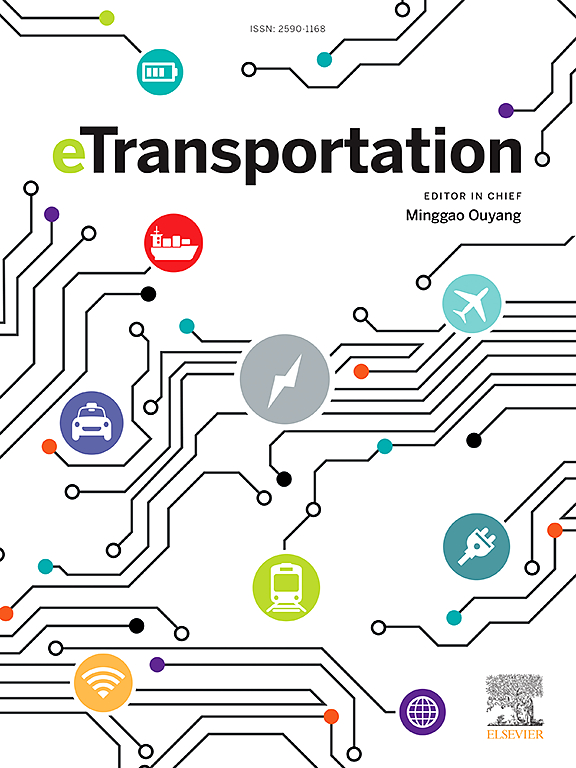储能系统与超快速充电站集成的技术经济分析:荷兰案例研究
IF 17
1区 工程技术
Q1 ENERGY & FUELS
引用次数: 0
摘要
在不断变化的能源格局和蓬勃发展的电动汽车(EV)市场中,快速高效的充电基础设施已成为不可或缺的一部分。无论充电站内部的交流(AC)或直流(DC)总线配置如何,主要关注的是充电需求的指数级增长,从而导致网络拥塞问题。在电动汽车呈指数级增长和低压配电网提供充电设施的背景下,配电网可能需要频繁升级以满足不断增长的充电需求。通过将储能系统(ESS)集成到超快速充电站(UFCS)中,避免网络拥塞问题,最大限度地降低运营费用(OE)。本文对安装电池ESS (BESS)的ucs进行了技术经济分析。为了减少对电网的依赖,最小化OE,提出了一个双目标优化问题,并通过网格搜索和双单纯形算法求解。采用解析能量模型和物理BESS模型对优化矩阵进行评价。研究了BESS老化的复杂性,以确保最佳的BESS尺寸具有比相应的投资回收期更长的寿命。集成的BESS大大减少了对电网的依赖,以解决网络拥堵,同时满足充电需求。动态定价(DP)结构被证明是更有利的,因为平均每单位成本仍然低于静态关税(ST)。结果表明,集成BESS可将OE和PAR分别降低5- 49%和16- 73%。此外,70% BESS和30%电网容量的组合优于其他配置,在BESS达到寿命终止之前,PAR降低73%,OE降低49%。本文章由计算机程序翻译,如有差异,请以英文原文为准。
Techno-economic analysis of energy storage systems integrated with ultra-fast charging stations: A dutch case study
A fast and efficient charging infrastructure has become indispensable in the evolving energy landscape and thriving electric vehicle (EV) market. Irrespective of the charging stations’ internal alternating current (AC) or direct current (DC) bus configurations, the main concern is the exponential growth in charging demands, resulting in network congestion issues. In the context of exponential EV growth and the provision of charging facilities from low-voltage distribution networks, the distribution network may require frequent upgrades to meet the rising charging demands. To avoid network congestion problems and minimize operational expenses (OE) by integrating energy storage systems (ESS) into ultra-fast charging stations (UFCS). This paper presents a techno-economic analysis of a UFCS equipped with a battery ESS (BESS). To reduce reliance on the electric grid and minimize OE, a dual-objective optimization problem is formulated and solved via grid search and dual-simplex algorithms. Analytical energy and physical BESS models are employed to evaluate the optimization matrices. The intricacies of BESS aging are examined to ensure an optimal BESS size with a more extensive lifespan than the corresponding payback period. The integrated BESS significantly reduced reliance on the grid to tackle network congestion while fulfilling charging demands. The dynamic pricing (DP) structure has proven more favorable, as the average per unit cost remains lower than the static tariff (ST). Results illustrate that integrating BESS reduces the OE and peak-to-average ratio (PAR) by 5-to-49% and 16-to-73%, respectively. Moreover, the combination of 70% BESS and 30% grid capacities outperforms the other configurations with a 73% reduction in PAR and a 49% reduction in OE before BESS reaches the end-of-life.
求助全文
通过发布文献求助,成功后即可免费获取论文全文。
去求助
来源期刊

Etransportation
Engineering-Automotive Engineering
CiteScore
19.80
自引率
12.60%
发文量
57
审稿时长
39 days
期刊介绍:
eTransportation is a scholarly journal that aims to advance knowledge in the field of electric transportation. It focuses on all modes of transportation that utilize electricity as their primary source of energy, including electric vehicles, trains, ships, and aircraft. The journal covers all stages of research, development, and testing of new technologies, systems, and devices related to electrical transportation.
The journal welcomes the use of simulation and analysis tools at the system, transport, or device level. Its primary emphasis is on the study of the electrical and electronic aspects of transportation systems. However, it also considers research on mechanical parts or subsystems of vehicles if there is a clear interaction with electrical or electronic equipment.
Please note that this journal excludes other aspects such as sociological, political, regulatory, or environmental factors from its scope.
 求助内容:
求助内容: 应助结果提醒方式:
应助结果提醒方式:


